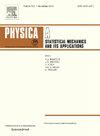幂律势的量子热力学
IF 3.1
3区 物理与天体物理
Q2 PHYSICS, MULTIDISCIPLINARY
Physica A: Statistical Mechanics and its Applications
Pub Date : 2025-06-09
DOI:10.1016/j.physa.2025.130728
引用次数: 0
摘要
量子热机建模为描述量子技术和设备的热力学特性提供了一种实用的方法。为此,幂律势常被用作量子热力学循环的工作介质,以研究热、功和效率的概念。考虑到这一点,我们提出了使用具有特征q指数的一般幂律势的量子热机的Stirling和Otto数值模拟的结果。我们计算了它的能谱,表明它能很好地恢复谐振子和一维势的传统形式。我们推导了在一个完整循环中减少的能量交换的表达式,以及作为指数q、浴池温度和频率比的函数的效率/性能系数。从这些结果中,我们确定了产生所需属性的参数,例如优化的性能和不同操作模式之间的转换。这些发现突出了类能势在优化量子热机中的作用,并支持了具有特定性能特征的定制发动机的设计。本文章由计算机程序翻译,如有差异,请以英文原文为准。
Quantum thermodynamics of a power-law potential
Modeling quantum thermal machines provides a practical approach to describing the thermodynamic properties of quantum technologies and devices. For this purpose, power-law potentials are often employed as working mediums of quantum thermodynamic cycles to investigate the concepts of heat, work, and efficiency. With this in mind, we present the results for the Stirling and Otto numerical modeling of quantum thermal machines that use a general power law potential with a characteristic exponent. We calculate its energy spectra, showing that it recovers the traditional forms of harmonic oscillator and 1-D potential well. We derive expressions for the reduced energy exchanges during a complete cycle and for the efficiency/coefficient of performance as a function of the exponent , the bath temperatures, and the frequency ratio. From these results, we identify parameters that yield desired properties, such as optimized performance and transitions between different operation modes. The findings highlight the role of power-like potentials in optimizing quantum heat engines and support the design of tailored engines with specific performance characteristics.
求助全文
通过发布文献求助,成功后即可免费获取论文全文。
去求助
来源期刊
CiteScore
7.20
自引率
9.10%
发文量
852
审稿时长
6.6 months
期刊介绍:
Physica A: Statistical Mechanics and its Applications
Recognized by the European Physical Society
Physica A publishes research in the field of statistical mechanics and its applications.
Statistical mechanics sets out to explain the behaviour of macroscopic systems by studying the statistical properties of their microscopic constituents.
Applications of the techniques of statistical mechanics are widespread, and include: applications to physical systems such as solids, liquids and gases; applications to chemical and biological systems (colloids, interfaces, complex fluids, polymers and biopolymers, cell physics); and other interdisciplinary applications to for instance biological, economical and sociological systems.

 求助内容:
求助内容: 应助结果提醒方式:
应助结果提醒方式:


